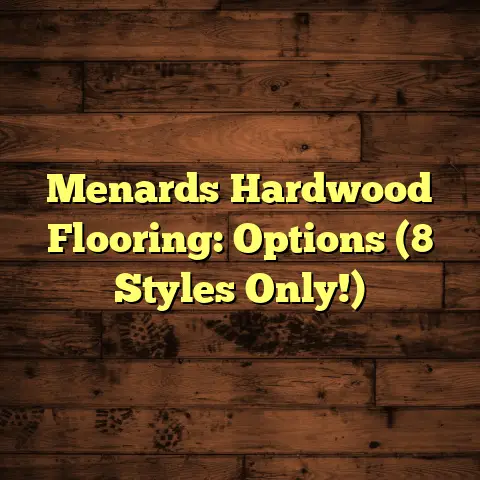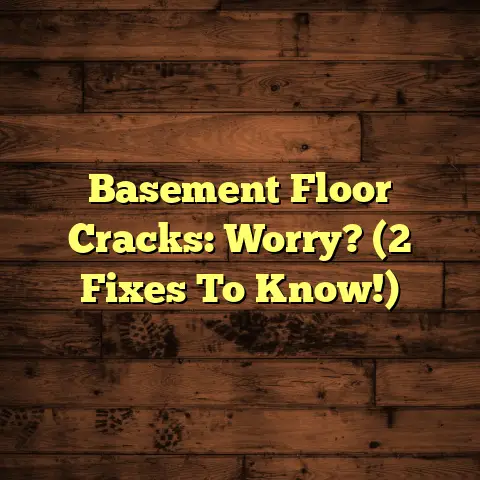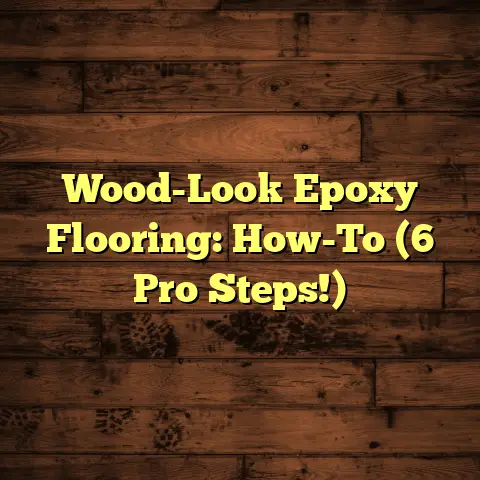Match Multi-Width Wood Floors: Style Guide? (3 Styles Clash!)
I’m your friendly neighborhood flooring contractor, and let me tell you, I’ve seen it all when it comes to floors.
From the good, the bad, and the downright disastrous!
Flooring is more than just something to walk on.
It’s the foundation of your home’s style, comfort, and even its resale value.
Think about it: It’s the first thing you feel when you walk into a room and often the largest surface area.
That’s why choosing the right flooring is crucial.
Lately, I’ve been getting a ton of questions about multi-width wood floors.
They’re super popular right now, and for good reason.
They add a unique, custom look to any space.
But here’s the thing: mixing different widths can be tricky.
It’s easy to end up with a style clash that leaves you scratching your head.
So, in this guide, I’m going to break down how to successfully incorporate multi-width wood floors into your home, even if your design styles are a bit… different.
Let’s dive in!
Section 1: Understanding Multi-Width
Wood Floors
Okay, so what exactly are multi-width wood floors?
Simply put, they’re wood floors that use planks of varying widths.
Instead of all the planks being the same size, you might have a mix of 3-inch, 5-inch, and 7-inch planks.
This is different from traditional single-width flooring, where every plank is the same size.
Think of your classic hardwood floor – usually all the same width.
Types of Wood
Now, let’s talk wood types.
The most common woods
I see used in multi-width flooring are:
Oak: A classic choice, oak is durable, readily available, and takes stain well.
I often recommend this for high-traffic areas.Maple: Maple is known for its smooth grain and lighter color.
It’s a great option if you want a more modern, minimalist look.Hickory: Hickory is one of the hardest domestic woods, making it incredibly durable.
It has a lot of character with its grain patterns, perfect for a rustic vibe.-
Other Options: You might also see things like walnut, ash, or even exotic woods like Brazilian cherry used in multi-width floors.
Table: Common Wood Types for Multi-Width Flooring
(Source: National Wood Flooring Association)
Benefits of Multi-Width Floors
So, why choose multi-width floors in the first place?
Here are a few key benefits I’ve noticed:
Visual Interest: The varying widths create a dynamic and eye-catching look.
It’s way more interesting than a uniform floor.Illusion of Space: Wider planks can make a room feel larger, while narrower planks can add a sense of intimacy.
By mixing them, you can play with the perception of space.Customization: Multi-width floors offer tons of customization options.
You can choose the specific widths, wood types, and laying patterns to create a truly unique floor.-
Hides Imperfections: A slight variation in plank height or subfloor unevenness is less noticeable with multi-width floors.
Ambiance Influence
The widths you choose can dramatically influence the overall ambiance of a room.
Wider planks tend to create a more relaxed, open feel.
They’re great for larger spaces where you want to emphasize the size of the room.
Narrower planks, on the other hand, can feel more formal and refined.
They work well in smaller spaces or areas where you want to create a sense of coziness.
Mixing both can give you the best of both worlds!
Section 2: The Clash of Styles
Alright, let’s get to the heart of the matter: style clashes.
I’ve identified three distinct design styles that often present challenges when integrating multi-width wood floors.
1. Modern Minimalism
Visual Characteristics: Think clean lines, simple shapes, and a focus on functionality.
Modern minimalism is all about stripping away the unnecessary and creating a sense of calm and order.
Key Elements:
- Neutral color palettes (whites, grays, blacks)
- Minimalist furniture with sleek designs
- Open floor plans
- Lack of clutter
Typical Color Schemes:
- Monochromatic (various shades of one color)
- High contrast (black and white)
- Use of natural materials like concrete and glass
Multi-Width Flooring Analysis:
Multi-width flooring can be tricky in a modern minimalist space because the style often leans towards uniformity.
The varying widths can sometimes feel too busy or chaotic for the clean, streamlined aesthetic.
However, it can work if you’re careful.
How to make it work:
Choose subtle width variations and stick to a consistent color palette.
For example, using planks that are all within a 1-2 inch range of each other (e.g., 4-inch, 5-inch, 6-inch) can add visual interest without overwhelming the space.
2. Rustic Charm
Visual Characteristics: Warm, inviting, and full of
character.
Rustic design celebrates natural materials,
imperfections, and a sense of history.
Think exposed beams, reclaimed wood, and cozy fireplaces.
Key Elements:
- Natural wood tones
- Use of stone and brick
- Distressed finishes
- Comfortable, oversized furniture
Typical Color Schemes:
- Earthy tones (browns, greens, creams)
- Warm reds and oranges
- Accents of metal and leather
Multi-Width Flooring Analysis:
Rustic charm is practically made for multi-width wood flooring!
The varying widths enhance the organic feel of the space and complement the use of reclaimed wood and mixed textures.
It’s a natural fit!
How to make it work:
Go bold with your width combinations.
Mix wide planks with narrow planks to create a dynamic and visually interesting floor.
Emphasize texture by choosing planks with knots, grain variations, and distressed finishes.
3. Eclectic Bohemian
Visual Characteristics: Vibrant, playful, and unapologetically unique.
Eclectic Bohemian design is all about mixing and matching different styles, patterns, and colors to create a space that reflects your personality.
Key Elements:
- Bold colors and patterns
- Mix of vintage and modern furniture
- Use of textiles like rugs, throws, and pillows
- Collection of unique objects and artwork
Typical Color Schemes:
- Rich jewel tones (purples, blues, greens)
- Warm oranges and yellows
- Unexpected color combinations
Multi-Width Flooring Analysis:
Eclectic Bohemian is another style where multi-width flooring can really shine.
The key is to embrace the contrast and create visual rhythms with the different widths.
Don’t be afraid to experiment!
How to make it work:
Mix and match widths boldly.
Use the flooring to create a visual anchor for the room.
Pair the flooring with colorful rugs, patterned furniture, and unique accessories to complete the look.
Section 3: Designing with
Multi-Width Wood Floors
Now, let’s get practical.
How do you actually
incorporate multi-width wood floors into each of these
styles?
I’ll walk you through some specific tips and tricks.
Modern Minimalism: Keeping it Cohesive
The key to making multi-width floors work in a modern minimalist space is to maintain a sense of cohesion.
Here’s how:
Subtle Variations: Choose widths that are close in size.
I’m talking about a difference of no more than 2 inches.
This will create a subtle visual interest without overwhelming the space.Consistent Color Palette: Stick to a single wood tone or a very limited range of tones.
This will help tie the floor together and prevent it from feeling too busy.Clean Lines: Opt for planks with a clean, straight grain pattern.
Avoid planks with a lot of knots or distressing, as these can detract from the minimalist aesthetic.-
Matte Finish: A matte finish will help to minimize shine and create a more understated look.
Case Study:
I recently worked on a modern condo where the client wanted multi-width floors but was worried about it clashing with their minimalist style.
We ended up using 4-inch, 5-inch, and 6-inch maple planks with a light stain and a matte finish.
The subtle width variations added just enough visual interest, while the consistent color palette and clean grain pattern kept the floor feeling cohesive and modern.
Rustic Charm: Enhancing the Organic Feel
With rustic charm, you have a lot more freedom to play with width combinations and textures.
Here are some tips:
-
Bold Width Combinations: Mix wide planks (7-inch or wider) with narrow planks (3-inch or narrower) to create a dynamic and visually interesting floor.
-
Natural Finishes: Choose planks with a natural finish that highlights the wood’s grain and texture.
Distressed Details: Look for planks with knots, grain variations, and distressed finishes.
These imperfections will add character and authenticity to the floor.-
Hand-Scraped Texture: Consider using hand- scraped planks for an extra touch of rustic charm.
Case Study:
I once installed multi-width hickory floors in a rustic cabin, and it turned out amazing.
We used a mix of 3-inch, 5-inch, and 7-inch planks with a hand-scraped texture and a natural oil finish.
The varying widths and distressed details perfectly complemented the cabin’s exposed beams, stone fireplace, and cozy furniture.
Eclectic Bohemian: Creating Visual Rhythms
Eclectic Bohemian is all about embracing contrast and creating visual rhythms.
Here’s how to make multi-width floors work in this style:
Mix and Match: Don’t be afraid to mix different widths, wood types, and finishes.
The more variety, the better!Unexpected Patterns: Experiment with different laying patterns, such as herringbone or chevron.
These patterns will add visual interest and create a sense of movement.-
Colorful Rugs: Use colorful rugs to define different areas of the room and add a pop of personality.
-
Unique Accessories: Pair the flooring with unique accessories, such as vintage furniture, patterned pillows, and eclectic artwork.
Case Study:
I helped a client design an eclectic living room with multi-width floors.
We used a mix of oak, maple, and walnut planks in varying widths and finishes.
The floor was intentionally mismatched to create a sense of playful contrast.
We then layered colorful rugs, patterned furniture, and eclectic artwork on top of the floor to complete the look.
It was bold, unique, and totally reflected my client’s personality.
Section 4: Overcoming Challenges
When Matching Styles
Okay, let’s be real. Integrating multi-width wood floors across different styles isn’t always easy.
There are some common challenges that homeowners face.
I’ve seen it all, trust me.
Common Challenges
-
Mismatched Color Tones: If the wood tones in your flooring clash with the colors in your furniture or walls, it can create a jarring effect.
-
Conflicting Aesthetics: If the style of your flooring doesn’t align with the overall style of your home, it can throw off the entire design.
Difficulty Achieving Balance: It can be difficult to strike the right balance between visual interest and cohesion.
Too much variation can feel chaotic, while too little can feel boring.
Strategies for Overcoming Challenges
So, how do you overcome these challenges and create a harmonious space?
Here are some strategies that I’ve found to be effective:
Use Area Rugs: Area rugs are a great way to define different areas of a room and tie together different styles.
Choose rugs that complement the color tones and patterns in your flooring and furniture.Coordinate Wall Colors: Wall colors can have a huge impact on the overall feel of a room.
Choose wall colors that complement the wood tones in your flooring and create a sense of harmony.Choose Furniture Wisely: Select furniture that aligns with the overall style of your home and complements the flooring.
Pay attention to the materials, colors, and shapes of your furniture.Incorporate Décor: Use décor to tie the spaces together.
This could include artwork, plants, lighting, and accessories.
Choose décor that reflects your personality and adds a personal touch to the space.
Example:
Let’s say you have a modern living room with multi- width oak floors.
The floors are beautiful, but you feel like they’re clashing with your existing furniture, which is more traditional in style.
Here’s how you could use these strategies to overcome the challenge:
Area Rug: Add a large area rug in a neutral color with a subtle pattern.
This will help to define the living area and soften the contrast between the flooring and the furniture.Wall Colors: Repaint the walls in a warm, neutral color that complements the oak floors.
This will create a more cohesive and inviting space.Furniture: Replace a few of the most traditional furniture pieces with more modern options.
For example, you could swap out a heavy, ornate coffee table for a sleek, minimalist one.Décor: Add some modern artwork and accessories to the room.
This will help to balance out the traditional elements and create a more harmonious look.
Conclusion
So, there you have it!
A comprehensive guide to
matching multi-width wood floors with different design
styles.
I know it can seem daunting at first, but with a little planning and creativity, you can create a stunning space that reflects your unique personality.
Remember, while multi-width wood floors can present stylistic challenges, they also offer incredible opportunities for creativity in design.
Don’t be afraid to experiment, mix and match, and find your own unique voice in home décor.
After all, your home should be a reflection of you!
And let’s not forget the enduring appeal of wood flooring.
It’s a timeless material that can adapt to evolving design trends and add warmth, character, and value to any home.
So go ahead, embrace the interplay of styles, and create a space that you truly love.
Your floors will thank you for it!





